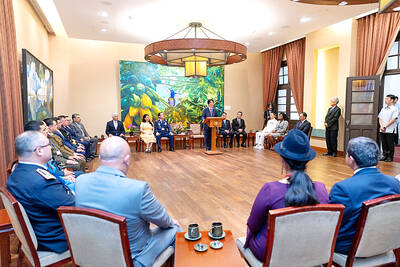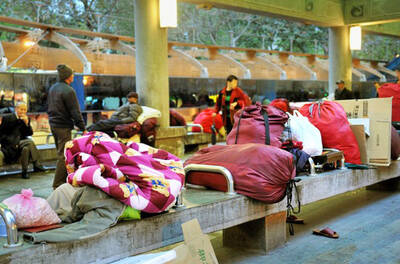While stagnant salaries have undermined many people’s quality of life and offered dismal prospects for younger generations, they inspired a 28-year-old man from Greater Taichung to pursue his dream of becoming a garage kit sculptor.
Garage kit sculptors create life-like figures depicting a wide range of objects, from cartoon and video game characters to robots.
From an early age, Chiang Chia-ching (江家慶) was interested in painting, clay and robots.

Photo: CNA
He discovered his talent for sculpting when he started attending kindergarten.
“I loved Transformers toys during my kindergarten years, but since my parents made a meager living peddling fruit at markets, we couldn’t afford them,” Chiang said. “Instead, they bought me two pieces of clay which I used to make my first sculpture — a Transformer.”
However, it was not that particular sculpture that paved the way for Chiang to become a talented sculptor, but rather his later experience at a clay modeling club in high school.
Chiang said he joined the club on a whim, as it was one of two student associations — a clay modeling club and an embroidery club — at his school and he decided to go for the one that he tought was “less feminine.”
In an effort to save up the money for the materials and the equipment he needed for his clay sculptures, Chiang walked to school, which took him nearly an hour each way, to save money on transportation.
Chiang continued to live thriftily during college, and he was able to afford to transform his ideas into vivid sculptures.
After being discharged from the military in 2008, Chiang, like most young Taiwanese men his age, found himself at a crossroads and, like most people, chose to get a “real” job instead of following his dreams.
However, holding down a reasonably paid job amid a sluggish economy was not easy, and most of the jobs Chiang applied for only paid salaries ranging from NT$16,000 to NT$22,000.
“It was then that I figured I might be better off pursuing my dreams than settling for such a meager salary,” Chiang said.
Chiang found a job in a studio in Changhua County that specialized in original equipment manufacturing (OEM) toy models, hoping to improve his techniques in modeling while getting paid.
Nevertheless, the labor-intensive nature of the job, coupled with the considerable time it took him to commute from Taichung to Changhua by motorcycle, left him exhausted.
“Sometimes I found myself falling asleep while waiting at traffic lights,” Chiang said.
When his employer started withholding wages in 2009, Chiang decided to take a leap of faith and flew to Japan with five garage kits he created to make his debut at the celebrated semi-annual Wonder Festival.
Chiang’s creations sold out at quickly, making his name known to garage kit hobbyists both at home and abroad.
Over the course of the past three years, Chiang has matured from being an amateur artist into an up-and-coming sculptor, whose works of art have not only attracted orders from department stores in Taiwan and overseas, but also helped him win a championship for professional Asian sculptors in Japan last year.
“Being a garage kit sculptor may involve hard work and long hours, but at least I’m making enough to avoid becoming one of those destitute artists people always talk about,” Chiang said.
Chiang joked that his father would occasionally stop by his house to ensure that he had not starved to death.
Talking about his future, Chiang, who also works at a vocational school teaching toy manufacturing, said he would continue doing what he enjoyed doing most and did best.
“The feeling of being able to turn something that only exists in the mind into a real object is by far the most thrilling part of living my dream,” Chiang said.
Saying he had created a number of prototype sculptures that would be mass-produced in China before being sold on the Internet, Chiang said it was a pity that the demand for garage kits was so limited in Taiwan that few sculptors could make a living in their home country.

Costa Rica sent a group of intelligence officials to Taiwan for a short-term training program, the first time the Central American country has done so since the countries ended official diplomatic relations in 2007, a Costa Rican media outlet reported last week. Five officials from the Costa Rican Directorate of Intelligence and Security last month spent 23 days in Taipei undergoing a series of training sessions focused on national security, La Nacion reported on Friday, quoting unnamed sources. The Costa Rican government has not confirmed the report. The Chinese embassy in Costa Rica protested the news, saying in a statement issued the same

Taiwan’s Liu Ming-i, right, who also goes by the name Ray Liu, poses with a Chinese Taipei flag after winning the gold medal in the men’s physique 170cm competition at the International Fitness and Bodybuilding Federation Asian Championship in Ajman, United Arab Emirates, yesterday.

A year-long renovation of Taipei’s Bangka Park (艋舺公園) began yesterday, as city workers fenced off the site and cleared out belongings left by homeless residents who had been living there. Despite protests from displaced residents, a city official defended the government’s relocation efforts, saying transitional housing has been offered. The renovation of the park in Taipei’s Wanhua District (萬華), near Longshan Temple (龍山寺), began at 9am yesterday, as about 20 homeless people packed their belongings and left after being asked to move by city personnel. Among them was a 90-year-old woman surnamed Wang (王), who last week said that she had no plans

TO BE APPEALED: The environment ministry said coal reduction goals had to be reached within two months, which was against the principle of legitimate expectation The Taipei High Administrative Court on Thursday ruled in favor of the Taichung Environmental Protection Bureau in its administrative litigation against the Ministry of Environment for the rescission of a NT$18 million fine (US$609,570) imposed by the bureau on the Taichung Power Plant in 2019 for alleged excess coal power generation. The bureau in November 2019 revised what it said was a “slip of the pen” in the text of the operating permit granted to the plant — which is run by Taiwan Power Co (Taipower) — in October 2017. The permit originally read: “reduce coal use by 40 percent from Jan.